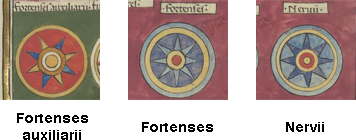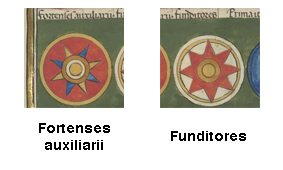
This page created 8 April 2014, and last modified: 27 October 2015 (Jones reference added)

The Fortenses auxiliarii is listed (15.28 in Ingo Maier's numbering scheme) as the third of the pseudocomitatenses units under the Magister Militum per Orientem. Its shield pattern (14#9), as shown in various manuscripts under the matching label (14.i) Fortenses auxiliarii, is as below:

The shield pattern has a yellow boss (white in B) surrounded by a blue band (white in P) which is itself surrounded by a yellow band (white in M). The shield's rim is yellow (white in M), while the main field is red (white in B) and feature as 8-pointed star, with the points alternating yellow (white in M) and blue. The unit's name means something like "the Fortenses' assistants", and as it turns out, the 8-pointed star shield pattern of the Fortenses (9.20) under the Magister Militum Praesentalis I is similar to that of the Fortenses auxiliarii, as can be seen from following patterns taken from the Paris manuscript:

This strongly implies the Fortenses auxiliarii were at one point brigaded with the Fortenses, at which time the Fortenses auxiliarii received its name and shield pattern. However, the Fortenses is a senior palatine unit under the senior eastern Magister, and as can be seen above, its shield pattern is even more similar to that of its next-closest-ranked unit under the same commander, the Nervii, with which it was undoubtably normally brigaded.
Thus it would appear that the Fortenses auxiliarii was only at some point associated with the more senior Fortenses, hence its name and pattern, but was later posted elsewhere. Given the pseudocomitatenses status of the Fortenses auxiliarii, this would imply a relatively recent posting to the Magister Militum per Orientem from a limitanei command, and not a palatine army like that of the first Master of the Soldiers in the Imperial Presence.
It has been postulated that the Fortenses auxiliarii is to be equated with the Legio Fortenses identified by Ammianus as being at the siege of Amida, where it was just one of seven defending "legions", although Ammianus' text as it has come down to us may have been corrupted, for apparently 8 units are listed, not 7: the Legiones V Parthica, Magnetiaci, Decentiaci, Tricensimani, Decimani, Fortenses, Superventores, & Praeventores. Although it has been proposed that the text be amended to "Decimanique Fretenses", thereby reducing the number of legions by one, and also turning Ammianus' 10th into a descendent of Legio X Fretensis rather than Legio X gemina, if this proposed amendment is not taken up, then Ammianus' Fortenses would indeed seem an attractive candidate to equate to the Fortenses auxiliarii, since it is a limitanei unit coming from just the right area.
It would then remain to explain how it received its shield pattern and auxiliarii appellation, for it is tolerably clear the unit must be legionary rather than auxiliary: the name Fortenses is shared by several other legionary units in the Notitia in addition to the one already mentioned above, but no units clearly identifiable as auxiliaries. Further, the unit listing order in the section of the Magister Militum per Orientem would argue against auxiliary status - to have a unit of auxiliaries placed between two legionary units would be unique departure from the norm. The resemblance to the pattern of the Nervii may simply be a coincidence. The very next unit listed after the Fortenses auxiliarii also features a pattern bearing an 8-pointed star: the Funditores (15.29).

These patterns, while not particularly similar, are nonetheless close enough to posit a relationship; particular when considering they are adjacently listed units, and thus already quite likely to have been brigaded together on that basis alone. The auxiliarii part of the name may simply refer to the aid the unit brought to command on joining it. That would leave the Fortenses portion of the name still to be explained. In the absence of a connection with the Praesental Fortenses, the most likely origin of the unit would probably be from Legio secunda Traiana (56/7.13) under the Dux Thebaidos, as this legion was surnamed fortis.
It should be note however, that Jones considerd it self-evident that the Fortenses auxiliarii were to be equated with the western auxiliry unit the Auxilia Fortensia (143.27), under the Dux Provinciae Valeriae ripensis. But other than the similarities of names, I can see no reason why this such an identification should be made; the grammar does not lend ready support to the equation, for example, nor, as argued above, does the placement of the unit amongst non-auxiliary units.
1. Ingo Maier; "Appendix 4: Numeration of the new edition of the compilation 'notitia dignitatum' (Cnd)"; last accessed 26 October 2015. See also for here for numbering examples. Return
2. C.S. Lightfoot; "The Eastern Frontier of the Roman Empire with special reference to the reign of Constantius II", D.Phil. thesis, Oxford, 1982; available here (last accessed 27 October 2015); at p 107. Return
3. Ammianus Marcellinus ("Ammianus"); "Res gestae a fine Corneli Taciti", 18.9.3; available here in Latin and here in English (last accessed 27 October 2015). Return
4. A.H.M. Jones; "The Later Roman Empire, 284-602; A Social, Economic, and Administrative Survey"; Blackwell, Oxford, 1964; vol. 3 of 3, at p 353. Return

Return to the Notitia alphabetical unit list page.
Return to my Notitia index page.